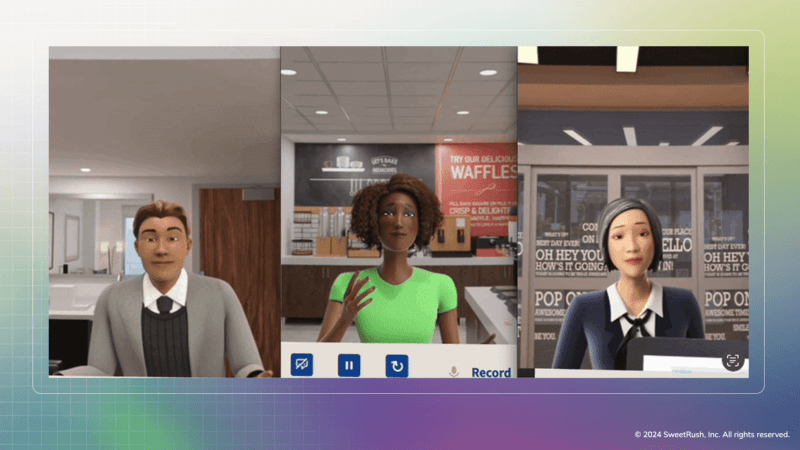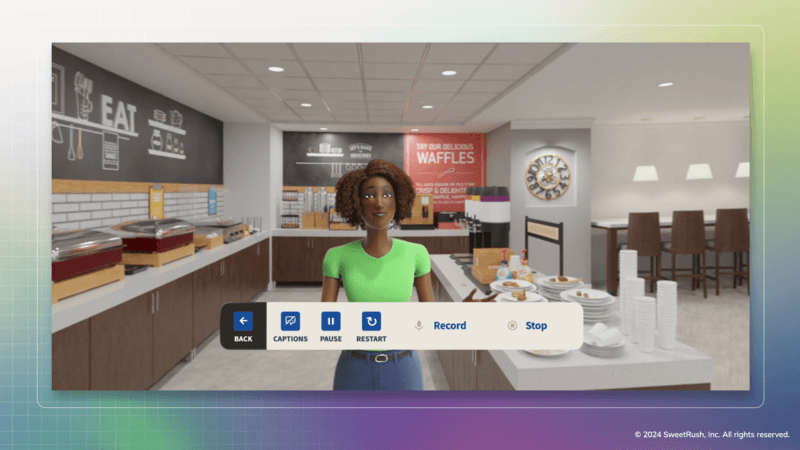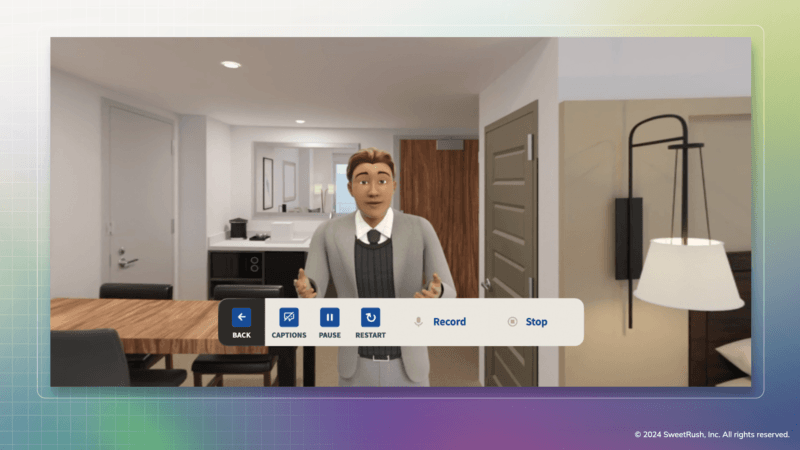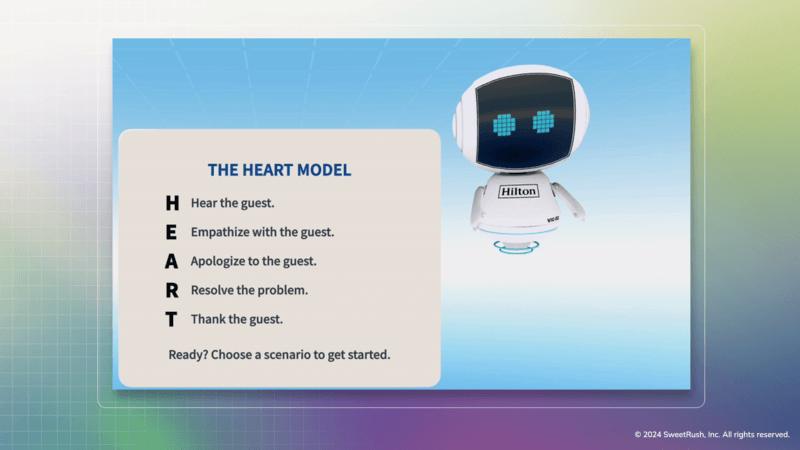How Hilton And SweetRush Created Generative AI Coaching

Expert Coaching And Immersive Learning At Scale
It’s no secret that generative AI has been having a moment—and with a history dating back to the 1940s, [1] its moment is proving to be pretty durable. At this stage, organizations and individuals have moved beyond using AI for rote tasks and are beginning to harness its power for more complex and nuanced functions. [2]
Though the use case is still emerging, the collective conversation about AI for Learning and Development continues to amplify and (exponentially) multiply. As so many L&D leaders upskill and experiment, we’re looking to our industry’s leading innovators for guidance, inspiration, and lessons learned.
Enter global hospitality leader Hilton, in collaboration with SweetRush, which is leveling up its immersive learning game with a generative AI, immersive coaching experience for its global family of hotel team members.
AI + Hilton: Soft Skills Coaching At Scale
Over the course of their ten-year relationship, the Hilton-SweetRush team has collaborated on numerous leading-edge learning experiences for all 400,000 of Hilton’s global team members. Hilton’s innovative learning portfolio includes effective, engaging Virtual Reality (VR) experiences such as Hotel Immersion and Exceed with Empathy, both of which transport learners into realistic scenarios that help them engage with, and build empathy for, guests and fellow team members.
In spring 2023, the team uncovered an ambitious use case for generative AI: creating a safe, authentic practice space where every hotel team member could practice their guest service skills and receive real-time coaching.
Here’s a look into the business need driving Hilton’s learning use case for a generative AI coaching experience—and how the Hilton-SweetRush team rose to meet the challenge in a few short months.
The Business Need: A Reliable, Friendly Stay For Every Guest
Drawing upon valuable insights from guest satisfaction surveys, Hilton identified the need to provide a warm, reliable, and welcoming stay that made every guest feel like a member of the family.
This need inspired the Hilton-SweetRush team to create a learning journey that empowered every hotel team member to provide outstanding guest service by focusing on the most impactful aspects of the stay.
This high-impact, highly engaging learning journey, called Make it Right, comprises a rich array of engaging eLearning modules, pre-shift team huddles, videos, and other bite-sized skilling activities.
One of the most challenging Make it Right skills is service recovery, or problem resolution. When a guest approaches a hotel team member with an issue, they’re offering an opportunity not only to repair the concern, but also to cement their loyalty.
Here’s the opportunity: getting service recovery can create an even stronger bond with a guest than delivering a flawless experience initially—a phenomenon known as the Service Recovery Paradox. [3]
To empower hotel team members to rise to the opportunity, Hilton empowers them to resolve guest problems using the five-step HEART model (below).

At this stage of the Make it Right journey, learners are familiar with the HEART model and its five steps. However, translating this knowledge into practice, particularly in high-stakes situations, is incredibly challenging.
Like any interpersonal skill, service recovery requires trial and error—and plenty of coaching to guide learners and provide insight into what works. Yet Hilton didn’t want to jeopardize real guest relationships as learners practiced this vital skill.
Hilton’s hotel team members faced a well-known dilemma: they needed to practice their service recovery skills, but service recovery is far too important to get wrong.
But the Hilton-SweetRush team had a way out of this impasse: they decided to build a safe practice space with plenty of room for trial and error—at zero risk to real guest relationships.
WebXR And Generative AI: Creating Expert Coaching And Safe, Immersive Practice Spaces
How did the team build this safe practice space?
By harnessing the power of WebXR content, the scalable, versatile VR technology that empowers learning teams to build an authentic 3D digital space where learners can practice to their hearts’ content—with zero risk to people, property, or relationships.
Learners access WebXR content either via a VR headset or the web browser on their smartphone, tablet, desktop, or laptop computer. This device optionality makes WebXR the perfect tool to bring the benefits of immersive learning to Hilton’s global learner audience.
This secure 3D digital environment is the foundation of Delivering on Our Customer Promise, an epic, immersive capstone experience that challenges learners with three different service recovery scenarios. Each scenario stars one of three digital guests who shares a concern about their stay—and waits for the learner to offer a resolution.

Using the HEART model as a guide, the learner responds by speaking into their device’s microphone while an expert coach stands by to support them.
Generative AI: Hilton’s Expert Soft Skills Coach
If the Hilton-SweetRush team’s use of WebXR guarantees the reach, relevance, and immediacy of the Delivering on Our Customer Promise capstone, then the addition of generative AI coaching elevates this experience to a new level of innovation.
This high-tech feature is founded in a thoroughly human use case: extending the benefits of one-on-one expert coaching to every learner in Hilton’s globally distributed audience.
Here’s a front- and back-end look at how it works.
After the learner speaks their response to the digital customer’s concern into their device’s microphone, the simulation converts their verbal input into a text transcript.
The transcript is then analyzed by a Large Language Model (LLM), which has been expertly trained by SweetRush SMEs for accuracy and consistency.
When the analysis is complete, the LLM delivers pass/fail grades and personalized feedback on the learner’s performance on each step of the HEART model.
E, or Empathize, is the step that typically presents the biggest challenge to learners. Even for Hilton’s big-hearted team members, it can be difficult to find the right words to express empathy.
There are plenty of opportunities to practice, though. After completing the scenario, the learner can choose either to reattempt it or move on to a new guest, receiving targeted feedback each time.
A Leading-Edge Learning Experience: Expert Soft Skills Coaching By VIC
To maximize the business impact of the Delivering on Our Customer Promise capstone, the Hilton-SweetRush team crafted three immersive scenarios, each addressing a common guest concern and unfolding in a different area of the hotel:
- Room climate controls
- Food and beverage options
- Unmet special room requests
Employing top-notch storytelling and dialogue, the team constructed branching interactions—set in-room, at the front desk, and in the breakfast area—that yield positive, negative, or neutral outcomes based on how the learner responds to each guest.
Working alongside Hilton SMEs, the team’s Learning Experience Designer meticulously crafted realistic guest comments and reactions that align with real guest commentary and Hilton’s proven service recovery methods.
In one scenario, a guest shares her frustration about a noisy air conditioning unit with a Hilton team member at the front desk. The learner’s mission: respond with HEART.

Another guest has missed breakfast due to work. The learner deploys their best HEART skills to offer her a prompt and heartfelt resolution.

This guest discovers that his request for additional in-room amenities hasn’t been fulfilled. Learners leverage the five steps of the HEART model to craft a prompt and effective resolution.
Reality, Virtually: Visual Design For A 3D Digital World
Realistic visuals are vital in creating a VR learning experience that is immediate, authentic, memorable, and transferrable to the learner’s daily work.
To create the settings in the Delivering on Our Customer Promise capstone, the Hilton-SweetRush team captured 360° footage during visits to real Hilton hotels.
The SweetRush Extended Reality (XR) team then added dimension and navigability to these settings—and populated them with digital characters who mirror the diversity and expressiveness of real Hilton guests. Just as real guests do, these characters express their mood and level of satisfaction through their tones of voice, gestures, and posture.
Given the complexity of the scenarios and the nuances of the service recovery process, the creative, instructional, and XR teams collaborated closely to ensure that content, audio, and visuals were seamlessly integrated throughout each scenario’s several possible outcomes.

The Hilton-SweetRush team wanted learners to add a personal touch to the Delivering on Our Customer Promise capstone, so they incorporated a friendly face to guide them through the experience. VIC, the friendly robot host—a popular recurring character throughout Hilton’s immersive learning portfolio—welcomes learners, provides instructions and HEART model guidance, and delivers detailed feedback on their performance.
Expert Coaching At Scale: Leading-Edge Soft Skills Training With Generative AI And WebXR
If you’ve loved this look into learning innovation at Hilton, don’t miss this behind-the-scenes look at the entire development process of the Delivering on Our Customer Promise capstone experience, featuring Hilton innovator Martess Green and SweetRush’s own learning technology experts.
From project management and Instructional Design to hardware management and analytics, you’ll learn about the skills and expertise your L&D team will need to create a generative AI coaching experience at your organization.
Got a high-stakes skilling need all your own? We’d love to chat about the possibilities to leverage generative AI and immersive learning for effective training experiences that engage your entire learner audience.
References:
[1] The History of Artificial Intelligence [2] The state of AI in 2023: Generative AI’s breakout year [3] McCollough, Michael A., and Sundar G. Bharadwaj. “The Recovery Paradox: An Examination of Customer Satisfaction in Relation to Disconfirmation, Service Quality, and Attribution Based Theories.” In Marketing Theory and Applications, edited by Chris T. Allen, 119. Chicago: American Marketing Association, 1992.Source link




